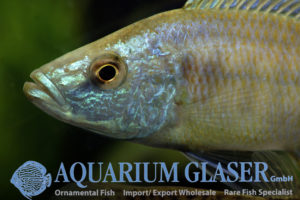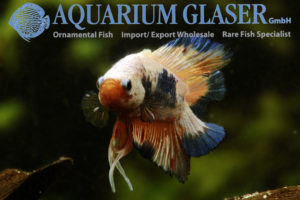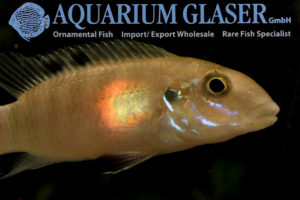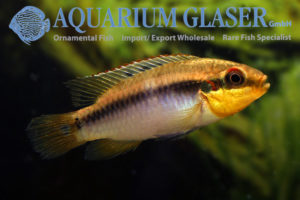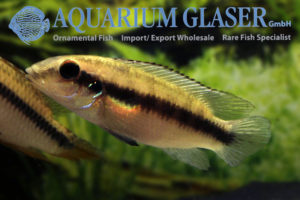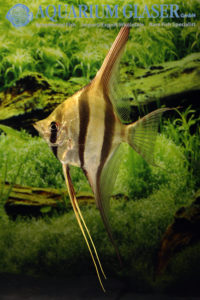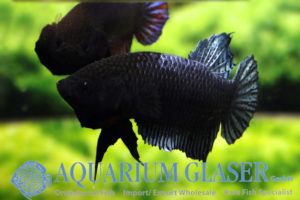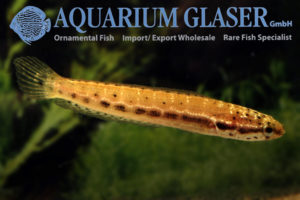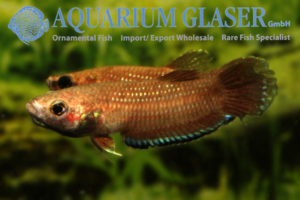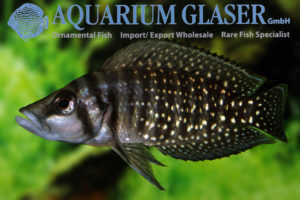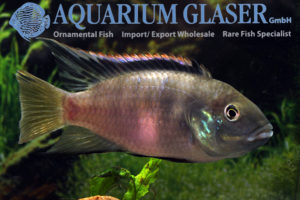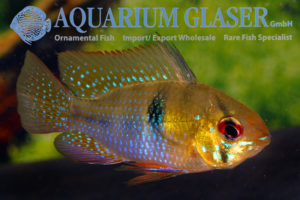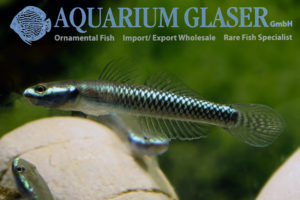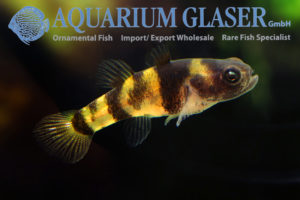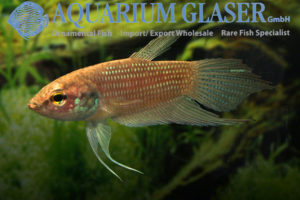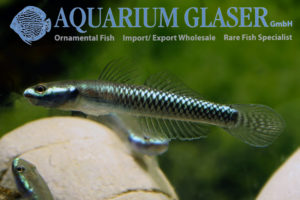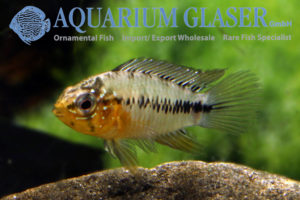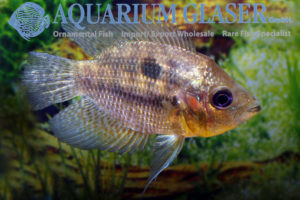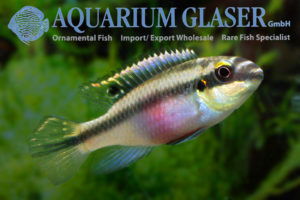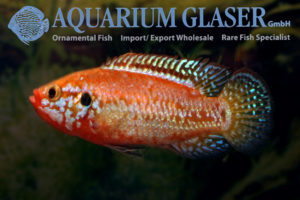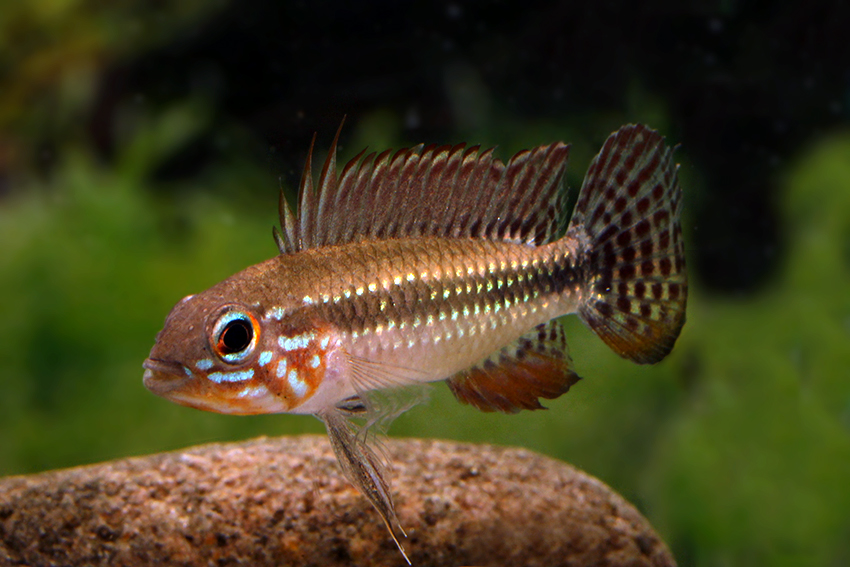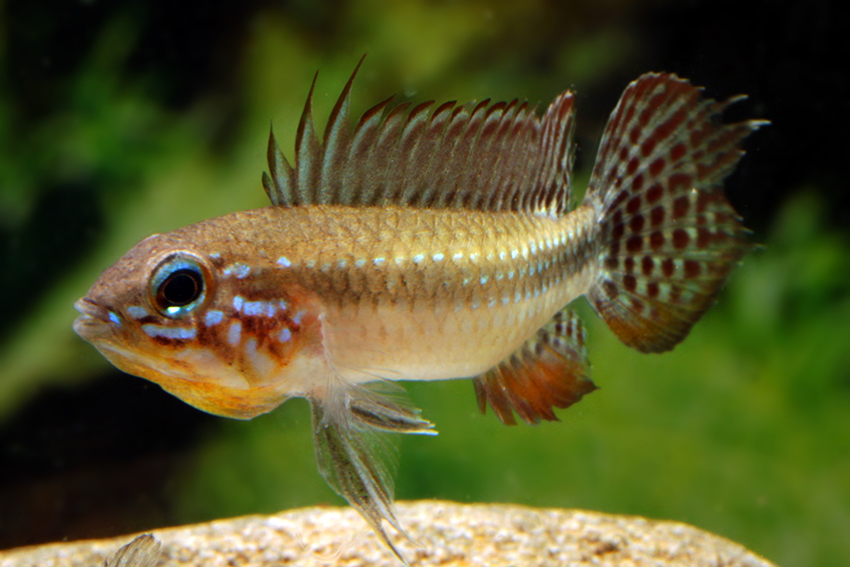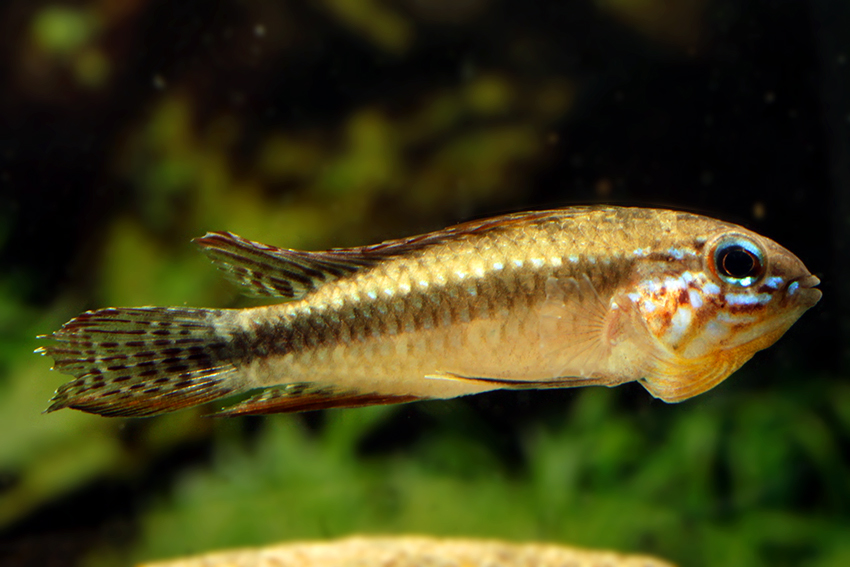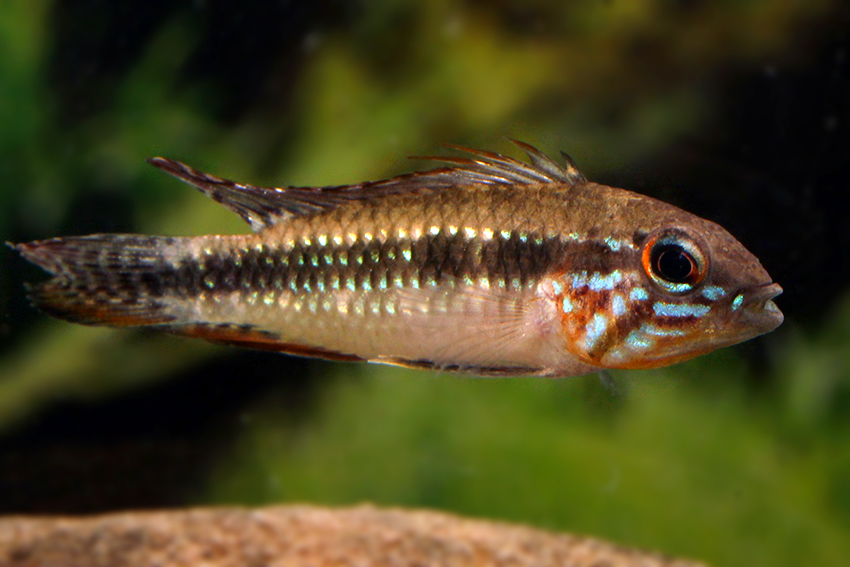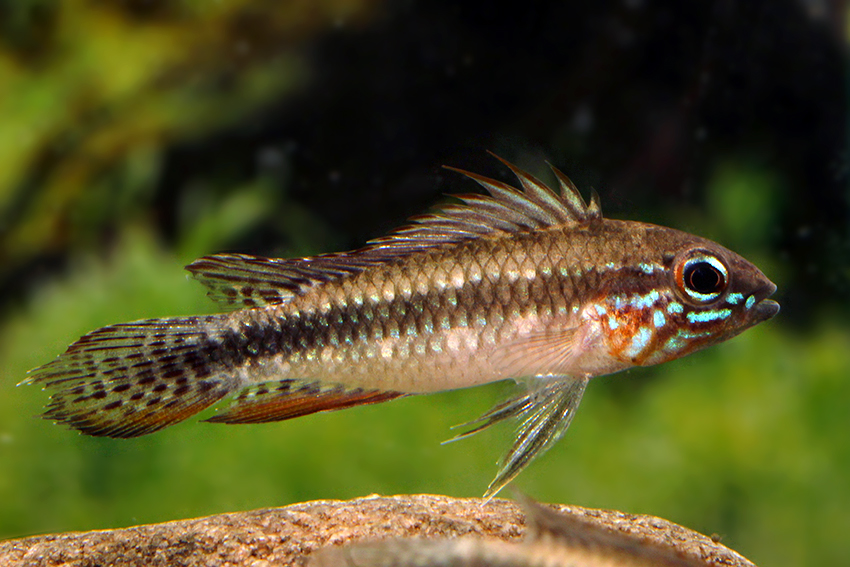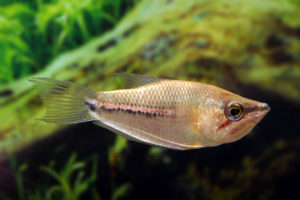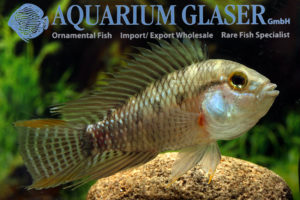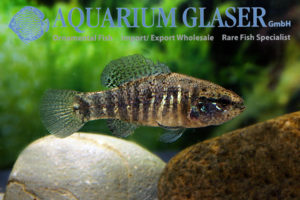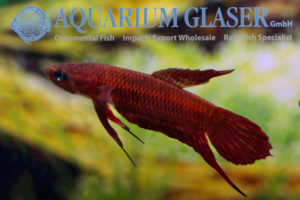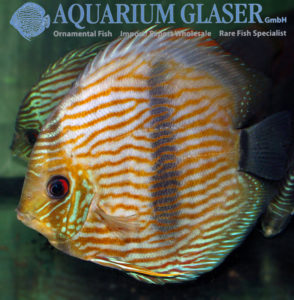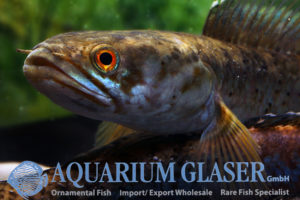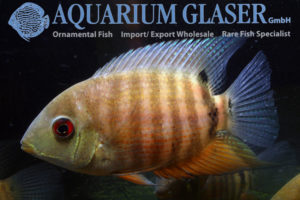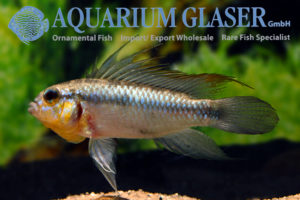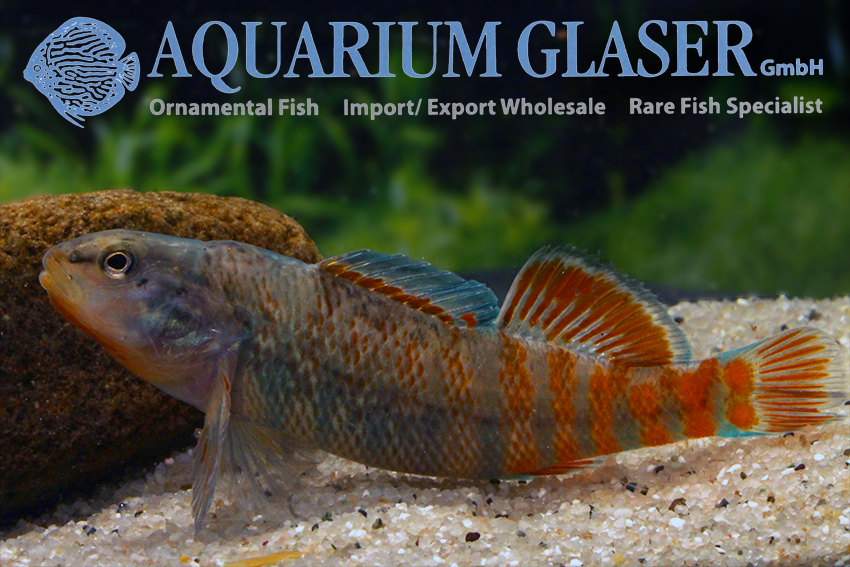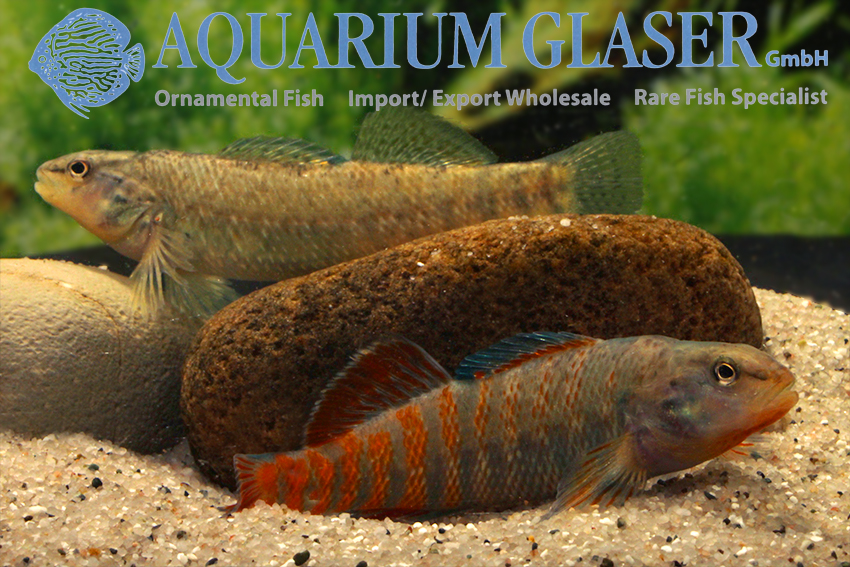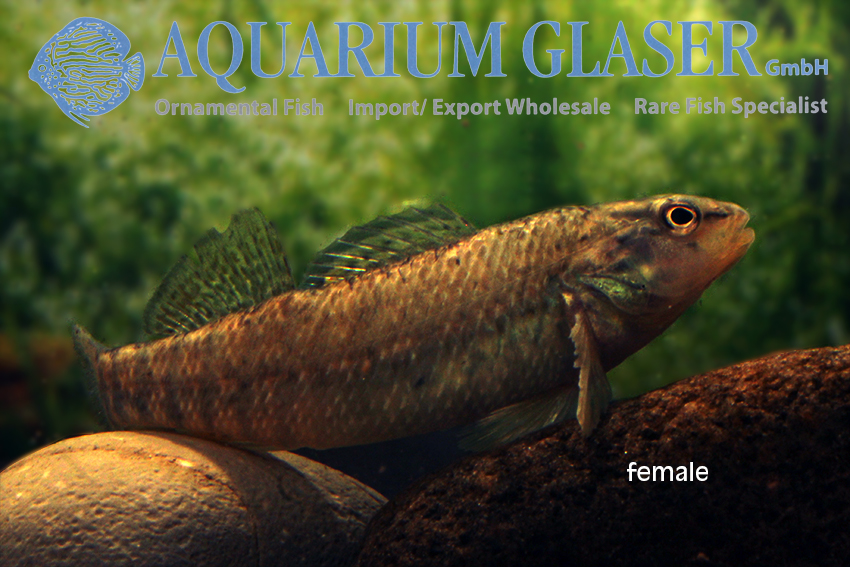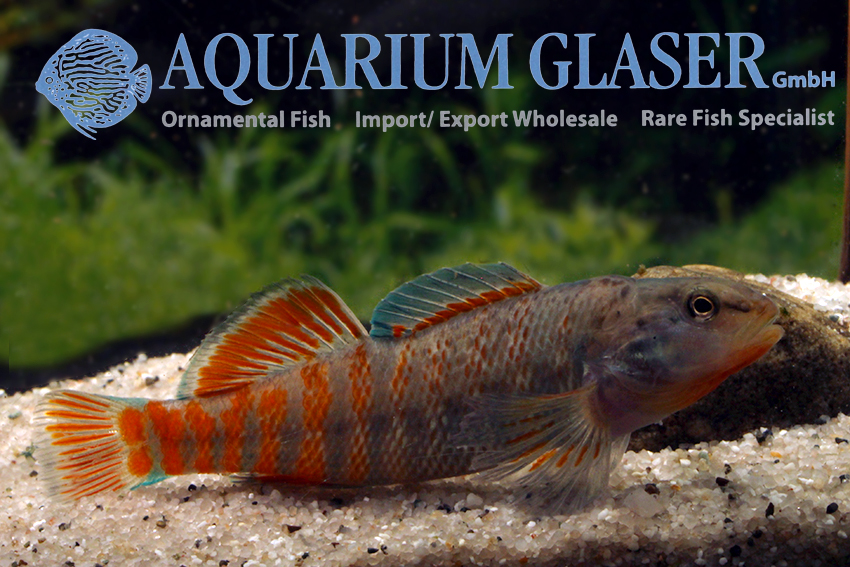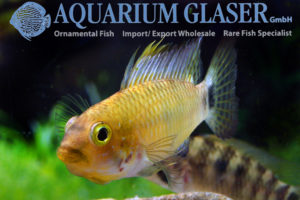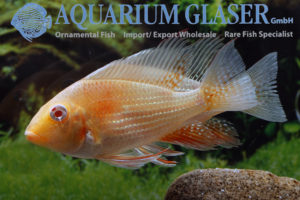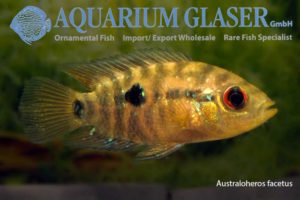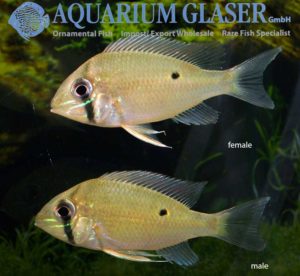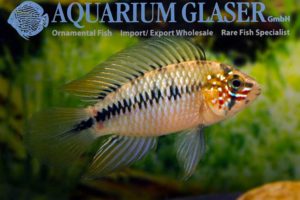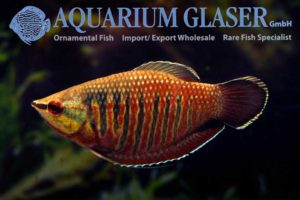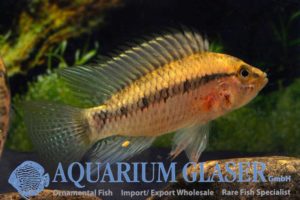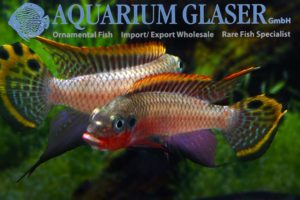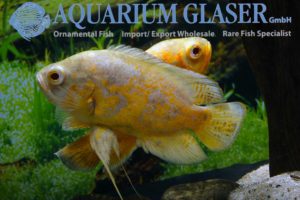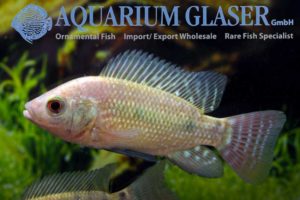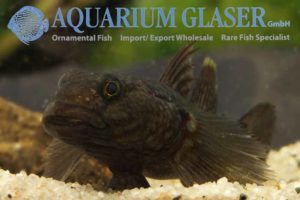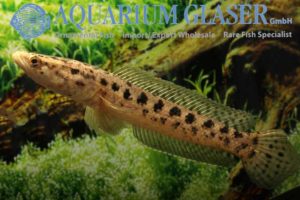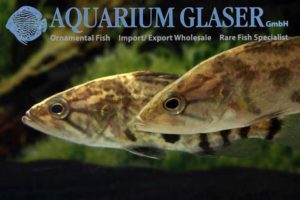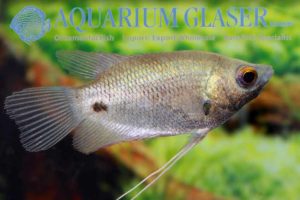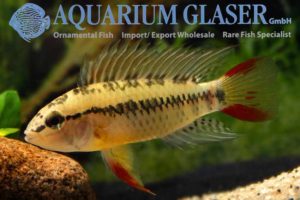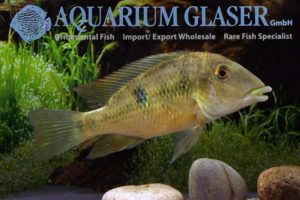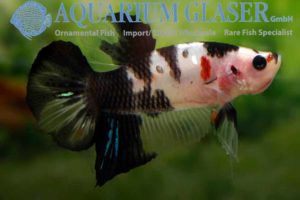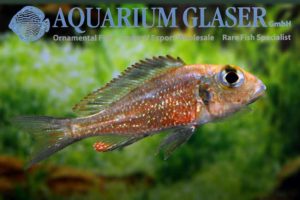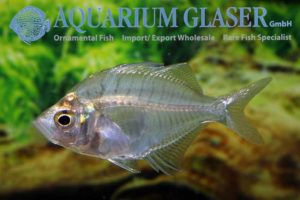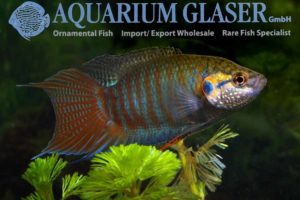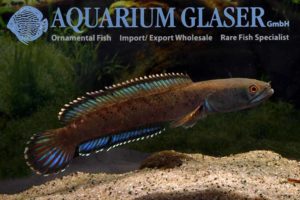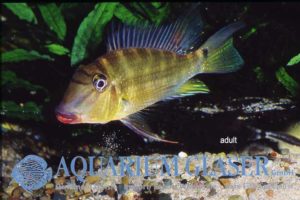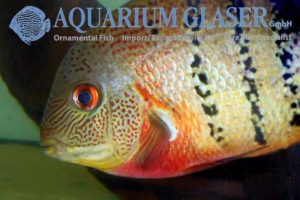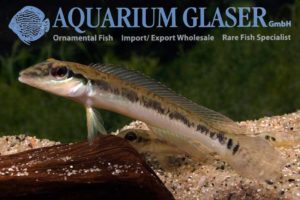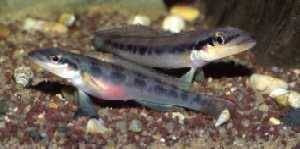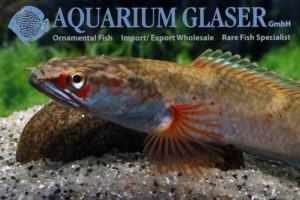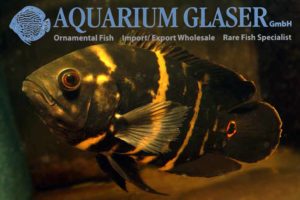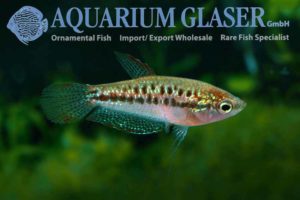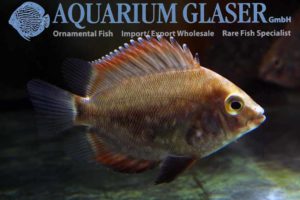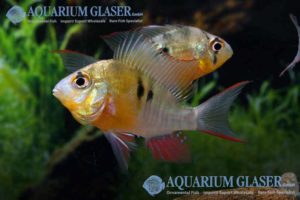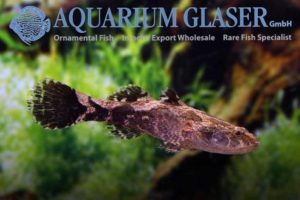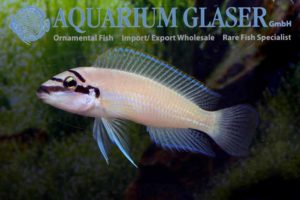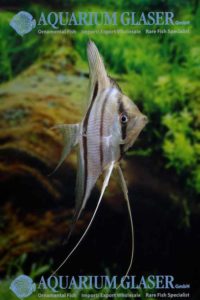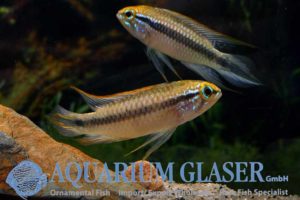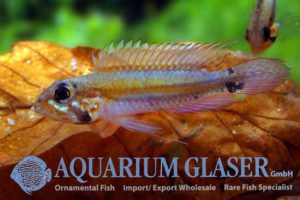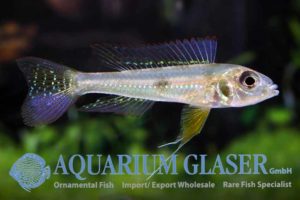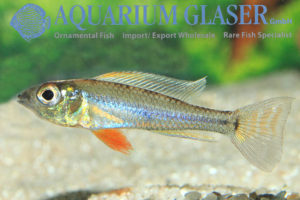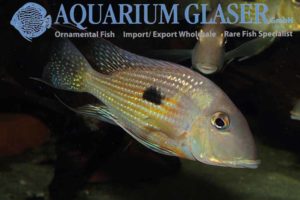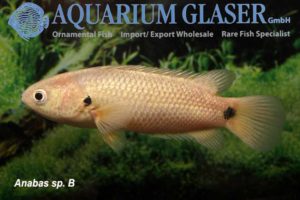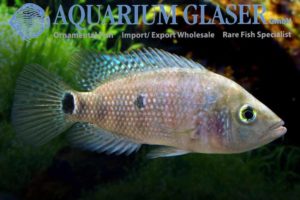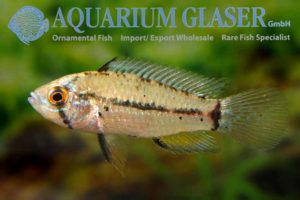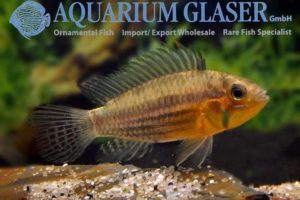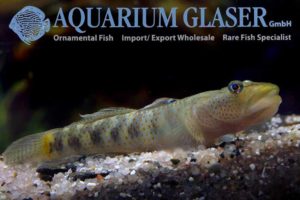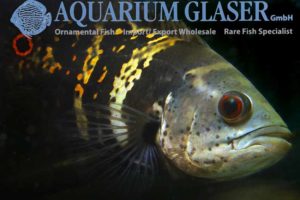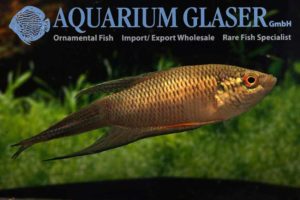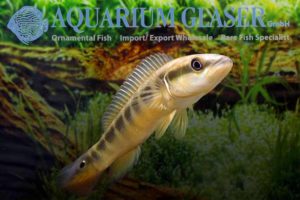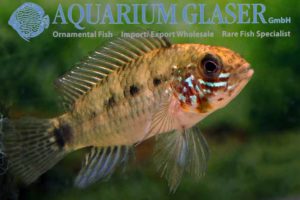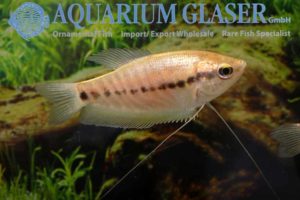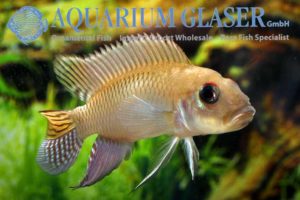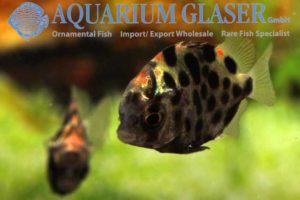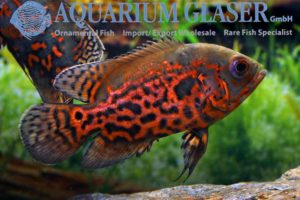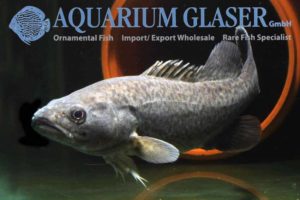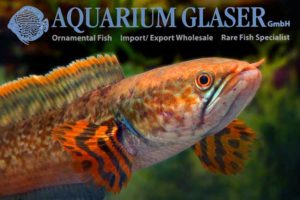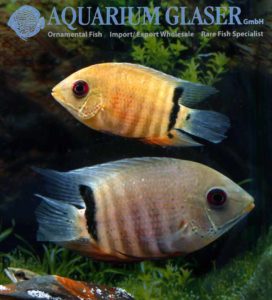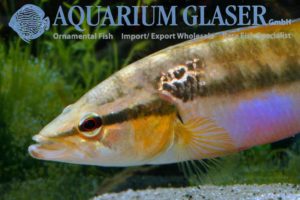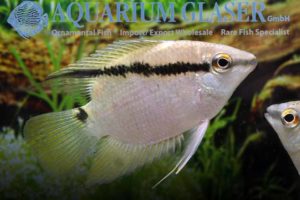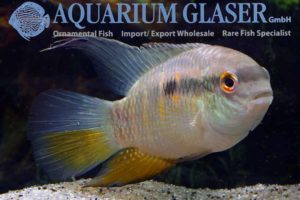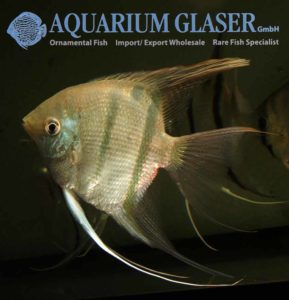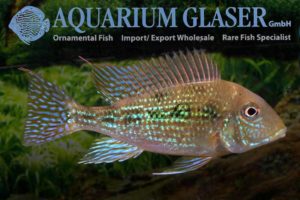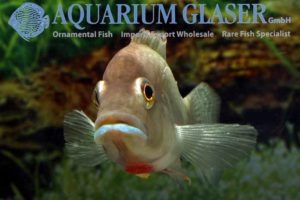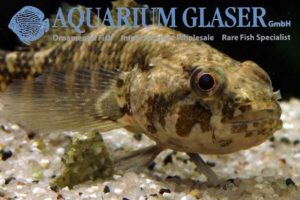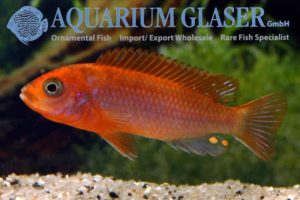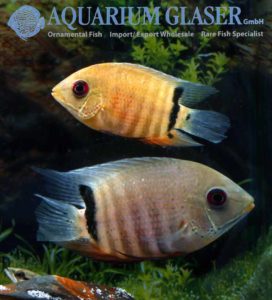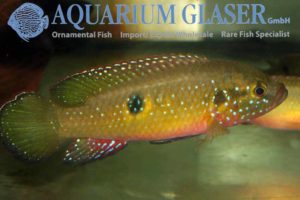The genus Dimidiochromis comprises currently four accepted species. Only one of them, D. compressiceps, is found in the trade on a regular basis and has become an ornamental fish so far. D. strigatus can still be considered a rarity in the trade. We have the species stocked now for the first time, our fish are […]
25. Perchlike fishes (885)
-
-
Another new sport of fighting fish: Fancy Dragon Pla Kat
Fighting fish are absolutely popular currently. The splendid colours, the easy breeding, the interesting behaviour and the unproblematic keeping are the reasons. Against other fish than conspecifics Betta splendens are usually completely peaceful; the only general exception are fancy guppys, as these are often erronously taken for male fighting fish and attacked. Until now the […]
-
Wallaceochromis signatus
Prior to its scientific description this species as been known in the hobby under the names of Pelvicachromis sp. „Bandi1“ or „Guinea“. The species can be always easily recognized by the black tailspot of the female. Usally the female has only one black spot in the dorsal fin; the fact that the photomodel from our […]
-
Pelvicachromis roloffi
The maybe rarest of all dwarf cichlids of the genus Pelvicachromis is P. roloffi. So we are very glad that in our current import from Guinea some specimens were included. This species depicts in almost all different moods a clearly visible, horizontal band. The females are – as usual in Pelvicachromis – the more colorful […]
-
Wallaceochromis humilis „Kasewe“
Finally we were able again to organize an import of – inter alia – dwarf cichlids from Guinea. Formerly all these fish were placed in the genus Pelvicachromis, but the species humilis, signatus, and rubrolabiatus have been transferred to the newly described genus Wallaceochromis in 2016. The naming of the different local populations of these […]
-
Wonderful bred Altum angels available!
The Altum angel (Pterophyllum altum) is extremely demanding during the rearing period. If the breeder makes even a minor mistake in respect of water quality or the food this results at once in a life-long deformation of the fish. These gnarled ventral fins, crooked anal fins or defects of the operculum are not heritable; so […]
-
Betta splendens – real fighter Pla Kat Luk Maw
It is a well known fact that the Betta splendens kept in the aquarium hobby as ornamental fish do not represent the species as it appears in the wild, but a domesticated fish. Initially this sport has been bred for combats, similar like sports of cocks and dogs. Only in the 1920ies, when supplying ornamental […]
-
Channa bankanensis
Many species of snakehead look very attractive as juveniles. Channa bankanensis is no exception from that rule. The reason for the sometimes extraordinary change in coloration is the behaviour. Juvenile Channa are usually schooling fish. Depending on the species they swim in close schools up to a length of 3 cm or even 15 cm. […]
-
Betta simplex
This small (5-6 cm) mouthbrooding species from Thailand is a very nice addition to the good assortment of wild collected Betta we currently have in stock. Betta simplex is a very close relative to the species Betta picta from Java, Betta falx from Sumatra, and Betta taeniata from Borneo. All the mentioned species share the […]
-
Altolamprologus calvus
This cichlid belongs to the most attractive species of the family from Lake Tanganyika. It attains a maximum length of about 13 cm. Despite the lurky look the fish is one of the most peaceful species of cichlid at all. One can say as a rule: if another fish is too large to serve as […]
-
Benitochromis nigrodorsalis
We can cvurrently offer a very small number of German bred specimens of a top rarity among the cichlids of western Africa: Benitochromis nigrodorsalis. This species has been described scientifically only in 2001. It originates from Cameroon and the island of Fernando Poo. Prior to the scientific descrption the fish was known as „Chromidotilapia finleyi […]
-
Wild Rams
Due to the regularly offered, amazing bred sports of the Ram (Mikrogeophagus ramirezi) one tends to forget, how breathtaking beautiful the wild collected fish is already. Currently we have fully grown, wild collected Rams from Venezuela in stock. By the way: wild collected Rams become only about 5 cm long (in males), females even stay […]
-
Stiphodon semoni
Once more we were able to import one of the gorgeous gobies belonging to the genus Stiphodon. This time we most likely received Stiphodon semoni, a species that is known for a long time already scientifically. It has been described already back in 1895. The species has a wide distribution, it is known from Sulawesi, […]
-
Brachygobius sabanus Thailand
We received this pretty species of bumblebee goby from Thailand. The determination of bumblebee gobies often proofes to be quite tricky; usually a big questionmark has to be set behind the names. Brachybobius sabanus has been described initially from Borneo (Sabah), our fish have been collected in Thailand. But the illustration accompanying the original description […]
-
Betta ferox
Sometimes we receive wild collected specimens of that very rare species of Betta. The mouthbrooding species is known so far only from a very small area in Thailand (Bori Pat). Here the fish inhabit brooks with soft and slightly acidic water. The water temperature there is around 25°C. Maximum length reported is about 8 cm, […]
-
Stiphodon semoni
Once more we were able to import one of the gorgeous gobies belonging to the genus Stiphodon. This time we most likely received Stiphodon semoni, a species that is known for a long time already scientifically. It has been described already back in 1895. The species has a wide distribution, it is known from Sulawesi, […]
-
Apistogramma borellii Paraguay wild
Recently we received beautiful wild collected specimens of A. borellii from Paraguay. This species is an ideal aquarium fish. In contrast to many other species of the genus A. borellii is completely undemanding regarding water chemistry. Even in medium hard, slightly alcalic water the species thrives well and even breeds. The behaviour of A. borelli […]
-
Chaetobranchopsis australis
Here it is: the cichlid with the probably most interesting mode of feeding from Paraguay! Chaetobranchopsis australis is specialized in feeding small planktic organisms. The up to 12-14 cm long fish swallows water like a vacuum cleaner and sieves the plankton with long gill rakers out of it. Obviously at the time of our importation […]
-
Pelvicachromis pulcher wild Yellow
The yellow sport of Pelvicachromis pulcher originates from southwest Nigeria. Here they are collected west of the Niger delta in the area of the Ethiop river. The names Yellow, Red or Green for the different sports of P. pulcher refers to the colour of the opercles; all of them get a red belly at times. […]
-
Hemichromis sp. Neon
If the only thing a hobbyist cares for for be the coloration, we would hardly need other species than Jewel Cichlids. The „Neon“ is an artifical sport, most probably bred by crossing different species and selection. The blue iridescent spots, present in most species of Hemichromis, are much larger in the „Neon“ sport. With respect […]
-
Sphaerichthys acrostoma
The Golden Chocolate Gourami may be the least attractive of all Chocolate Gouramis in respect of coloration, but it is nevertheless a very interesting species. The fish is the rarest of all Chocolate Gouramis as well in the hobby as in the wild. So we are very glad in case we are able to offer […]
-
Apistogramma eunotus „Rio Tapiche“
Apistogramma eunotus is among the species of Apistogramma with the deepest body of all. The species can be told apart from other, similar species, best by the large blueish spot on the opercle. We obtained recently very different specimens of A. eunotus from the Rio Tapiche in Peru. They differ in many respects from typical […]
-
Elassoma zonatum
Even our grandfathers will remember the dwarf sunfishes. The tiny, hardly 3 cm long fish are ideal inhabitants for small tanks that are not heated. Elassoma originate from the USA. Formerly only one species of the genus was represented in the hobby, namely Elassoma evergladei. But in the meantime additional species became avialable. Among them […]
-
Betta coccina
Finally we can offer once more one of the beautiful Bettas belonging to the relationship of the „small red ones“: Betta coccina. The Vinered fighter, also called the Blue spot fighter, comes from Sumatra, Jambi province. Like all these „small red ones“ it occurs in forests. Here the fish live among the dead leaves of […]
-
Discus Heckel Cross Jatapu
The high season for wild collected discus starts around October and ends in April. Nevertheless, good wild collected discus are available the whole year throught! Some varieties are in general very rarely offered, a good example are the so called Heckel Cross from the Rio Jatapu. They are real beauties! The out-of-season summer discus have […]
-
Channa sp. Meghalaya
Currently is the season for species of Channa from India. Every now and then we can offer the gorgeous Channa pardalis, which is also known in the hobby under the name of „True Blue“ (see http://www.aquariumglaser.de/en/fish-archives/channa_sp_true_blue_en/). There is a second, very similar Channa, traded under the name of Channa sp. Meghalaya. There is a rumour […]
-
Heros liberifer German bred
The mouthbrooding species of Heros from Venezuela has finally a widely accepted scientific name: Heros liberifer. Please see http://www.aqua riumglaser.de/en/fish-archives/the_mouthbrooding_heros_from_venezuela_a_new_species_heros_liberifer_en/ for detailed information on that case. From time to time we can offer beautiful, 10-14 cm long German bred specimens of that rare fish. For our customers: the animal has code 682945 on our stocklist. Please […]
-
Apistogramma trifasciata „Rio San Martin“
We received very nice German bred specimens of that dwarf cichlid. The specimens are descendants of the yellow-headed population that has been initially collected by the well known dwarf cichlid specialist and ichthyologist Dr. Wolfgang Steack in the Rio San Martin (Rio Guapore basin). He portrayed that population in detail in the DCG Sonderheft 2008 […]
-
Apistogramma personata Mitu
The identity of this dwarf cichlid – it belongs to the absolute top-rarities – is under discussion. It is a fact hat it has been collected for the first time in 1995 by Uwe Werner and company near Mitu, Colombia. The city of Mitu is placed at the banks of the Rio Vaupes. Uwe was […]
-
Acarichthys heckelii Albino
We received this extraordinary and beautiful sport of Acarichthys heckelii from Taiwan. A. heckelii is a comparatively large species of cichlid that can attain over the years a total length of more than 20 cm. And the fish becomes more and more beautiful with every year! The species is very peaceful. Aquarium maintenance is comparable […]
-
Chanchitos
The very first species of cichlid that was ever kept in private aquaria was the Chanchito. At that time – in the year 1894 – the species was classified as Heros facetum. Later it was transferred to Cichlasoma, nowadays it is placed in the comparatively new genus Australoheros. Initially it was thought that there would […]
-
Biotodoma wavrini BRAZIL
There are two accepted species of Biotodoma: B. cupido and B. wavrini. Both differ basically by the position of the lateral blotch, which is positioned above the upper branch of the lateral line in B. cupido and below the upper branch of the lateral line in B. wavrini. Biotodoma cupido is widely distrubuted in South […]
-
Apistogramma borellii WILD
We received beautiful, wild collected specimens of this dwarf cichlid from Paraguay. The species belongs to the members of the genus Apistogramma that are kept and bred in aquaria for decades already. The splendid males become almost double as large as the females. The peaceful and pretty species can be kept during the summer months […]
-
Sphaerichthys vaillanti
Finally we can offer again the most beautiful species of Chocolate Gourami: Sphaerichtys vaillanti. The species originates from the Kapuas basin in the Indonesian part of the island of Borneo. S. vaillanti is not only the most beautiful, but also the hardiest species of all Chocolate Gouramis. However, it is nevertheless by no means an […]
-
Apistogramma sp. Nanay
When we unpacked these large, fully grown Apistigramma from Peru we thought initially: wow, that kind of Apistogramma was never here before! The species-specific features of the fish are: stripes on the underside of the belly, an orange colored spot on the basis of the pecoral fin, a more or less clearly recognizeable orange zone […]
-
Pelvicachromis taeniatus NIGERIA RED
Dwarf cichlids from western Africa are bit out of fashion currently. Nobody knows a real good reason why, as usual in fashion. However, anyone who sees the gorgeous Pelvicachromis taeniatus “Nigeria Red” we can offer right now as German bred ones, will become crazy for a new fashion immediately and place a tank with these […]
-
Astronotus ocellatus Oscar Lemon
If one likes artifical sports or not is a matter of taste. But these sports are in any case interesting, because they show the genetic potential of a species. So finally men-made sports give hints even for the scientists working exlusively in the field how to distinguish local populations from different species. The Lemon Oscar […]
-
Oreochromis niloticus
There is most probably no other species of fish that is so much loved on the one hand and so much hated on the other: the Nile Mouthbrooder, often called simply „Tilapia“. As a food fish this omnivorous species – plant matter forms a large part of the diet – can be cultured even in […]
-
Papuligobius uniporus
For the first time ever we were able to import this interesting freshwater-goby from Vietnam. The species and the genus have been described only in 2003. Papuligobius uniporus attains a maximum length of about 7.5 cm. There exists only one other species in the genus, namely P. ocellatus, which has been described already in 1937, […]
-
Channa panaw
It was only in 1998 that this comparatively small species of snakehead was described as a separate species on its own. Before this the fish were thought to represent a geographical variety of the very far spread species Channa punctata. Channa panaw has a pretty far distribution in Burma, where it inhabits the area around […]
-
Coreoperca cf. liui
For the first time ever we obtained this interesting freshwater perch from southern China. The genera Coreoperca and Siniperca contain altogether 14 species. They are thought to be close relatives of the groupers (Serranidae), but are placed in a family on their own, the Sinipercidae. The fish were shipped under the name of Coreoperca kawamebari; […]
-
Osphronemus laticlavius
We received the very rare red finned giant gourami in two sizes, 5-7 cm (code 440923 on our stocklist) and 12-15 cm (code 440925). The species attains a similar size as the common giant gourami, eg 60 cm. O. laticlavius originates from Borneo. Fertile males develop a very prominent head structure and deep red fins […]
-
Apistogramma macmasteri Tame
It was back in 1996 when Uwe Werner presented in the Aqualog South American Cichlids II a dwarf cichlid under this name. The city and municipality of Tame are located in Colombia in the Arauca Department at the Rio Arauca. Here the unusual Apistogramma macmasteri have been collected. Sadly it became soon after lost for […]
-
Geophagus pellegrini
Sadly we can offer this beautiful mouthbrooding cichlid from Colombia only very rarely; the last time we had it in stock was 5 years ago. Now we had the opportunity to import this animal. They originate from the Chocó region in Colombia, located in the West of the country. The main river of the Chocó […]
-
Betta splendens Pla Kat Koi
Once more we were able to import an assortment of this extraordinary and extremely rare sport f fighting fish. The term “pla kat” is used for the short finned fish. We present to you in this newsletter some specimens of the current import (among them an extremely rare albino), for more pictures and informations, please […]
-
Callochromis macrops
Is this a species of Geophagus from Lake Tanganyika? One can get these thoughts when seeing Callochromis macrops the first time. However, this mouthbrooding sand cichlids belong to the large Haplochromis-relationship. The ability to change the coloration is breathtaking in this species. The same individual that right now looked silvery or blotched will become in […]
-
Parambassis siamensis
Formerly this species of glass perch was the most common found in the trade. It has a very wide distribution through Thailand, Vietnam, Cambodia, and Laos. However, Parambassis siamensis was most often mis-identified and traded under the name “Chanda wolfi”. P. siamensis is very similar to the Indian species P. ranga. Both are distinguished by […]
-
Macropodus opercularis WILD
The Paradise fish was the first exotic species (leaving the goldfish aside) of ornamental fish that reached Europe. This was back in 1869. Wild collected specimens are hardly ever available. We now could import wild caughts of that fantastic aquarium fish from China via Hongkong. The black throat with white spots that is shown by […]
-
Channa sp. True Blue
We could import this extreme beautiful species of snakehead in very small numbers from the north of India. The True Blue is obviously a close relative of C. stewartii; both attain a length of about 25 cm. The two photographed specimens have a quite different pattern. Most probably the smaller specimen is a female (it […]
-
Satanoperca rhynchitis
We received beautiful German bred specimens of this rare eartheater. Until the species has been described in 2012 under the name of Satanoperca rhynchitis it was known in the hobby as Satanoperca sp. “Red Lips”. The fish develop the pretty red lips only when adult, so we add a picture of an adult specimen to […]
-
Heros sp. Curare
For the first time ever we were able to import this splendid species of Heros. Reportedly the animals have been collected in the Rio Curare (name). However, we haven´t eard of a Rio Curare so far. We think the fish have been collected in the Rio Ventuari. The fish are extremely colorful; all other features […]
-
Teleocichla centrarchus
Teleocichla are small cichlids from Brazil. They love comparatively strong current. The genus is a close relative of the pike cichlids (Crenicichla). The genus teleocichla has been discovered only late, in 1988; currently 18 different species are known, 10 of them are still undescribed scientifically. Genus type is T. centrachus; we can offer now once […]
-
Teleocichla centrarchus
Teleocichla centrachus from Rio Xingu probably is the most imported Teleocichla. In addition, it is the type species of this kind. As the males have a maximum length of approx. 10cm, you can certainly still call them dwarf cichlids. The females, being mostly only 8cm maximum, are a little smaller and rather soon show a […]
-
Channa sp. Fire & Ice
Once more we can offer this small and colourful snakehead. The species attains a maximum length of only 12-15 cm. The fish belongs to an so far scientifically undescribed species which is found in the region of the Burmese-Thai border. The beautiful species belongs to the closer relationship of Channa gachua. Like this species, it […]
-
Astronotus cf. crassipinnis
There is no other genus of larger cichlids from South America that is so poorly understood as the oscars (Astronotus). Currently only two species are widely accepted, namely A. ocellatus and A. crassipinnis. However, there do exist a lot of more species as can be easily observed with the bare eye. We were able in […]
-
Trichopsis pumila
The Sparkling Gourami (Trichopsis pumila) is one of the smallest species of anabantoid at all – and one of the prettiest! The charming and totally peaceful species attains a maximum length of only 3-4 cm and is perfectly suitable for an community tank with other tiny, peaceful species of fish. The tank should be well […]
-
Uaru amphiacanthoides, bred
Only very view species of cichlid have such a drastic change of coloration during growing like Uaru amphiacanthoides. We can offer currently very nice bred ones. Uaru are close relatives of the discus. Like discus they wear the dorsal fin almost always spread. However, Uaru are mainly vegetarians. For more information and pictures of adult […]
-
Mikrogeophagus altispinosus
The Bolivian Ram, Mikrogeophagus altispinosus, is by far less popular than its well known cousin from Venezuela, the Common Ram (M. ramirezi). Maybe this is due to the fact that the Bolivian is traded almost exclusively as bred ones, because there are no commercial exports from the area where the species occurs naturally? But the […]
-
Oxyeleotris marmorata
Most gobies live in the sea. And most gobies stay small, usually less than 10 cm. So Oxyeleotris marmorata, the Marbled Sleepergoby, is an exception in more than only one respect. The species is a giant among the gobies and becomes more than 50 cm long. And usually it lives in pure freshwater; only occasionally […]
-
Chalinochromis brichardi
This pretty cichlid from Lake Tanganyika is only very, very occasionally found in the trade. This is hard to understand. Despite the fact that the coloration is rather simple, the fish are quite conspicuous. Keeping and breeding can be compared with the closely related genus Julidochromis. Maximum size of Chalinochromis brichardi is about 12 cm. […]
-
Pterophyllum scalare WILD Rio Xingu
We received very nice wild collected angels from the Rio Xingu in Brazil. The animals are “real” P. scalare with pointed snouts. They will most probably grow up to impressive, large fish. For our customers: the fish have code 699853 on our stocklist. Please note that we exclusively supply the wholesale trade. Available in limited […]
-
Apistogramma agassizii Tefé II and A. geisleri
We received very nice wild ciollected specimens of this variety of A. agassizii. One must not confuse these fish with the variety known as “Tefé I” (see http://www.aquariumglaser.de/en/fish-archive/dwarfcichlids-en/Apistogramma_agassizii_Tefe_en/), which is distinguished from all other varieties of A. agassizii by the additional rows of zigzag-bands on the belly. The variety “Tefé II” is characterized by a […]
-
Apistogramma diplotaenia
This dwarf cichlid is one of the most unusual members of the large genus Apistogramma. The very slim animals have a pattern of two longitudinal stripes. This is unique among Apistogramma and makes A. diplotaenia unmistakable. Sadly this species is offered only very rarely. Currently we have both wild collected fish (see photos) and bred […]
-
Biotoecus opercularis
We received beautiful, fully grown wild collected Biotoecus opercularis from Brazil. Formerly these sandhill-builders (see http://www.aquariumglaser.de/en/fish-archive/dwarfcichlids-en/biotoecus-opercularis-3/) were said to be extremely demanding and difficult to keep. Our recent imports, however, are very, very stout and healthy animals! For our customers: the fish have code 634493 on our stocklist. Please note that we exclusively supply the […]
-
Biotoecus opercularis
This fish probably represents the most interesting species of dwarf cichlids from Amazonia. Currently we were able to import it once more. B.opercularis is for sure not demanded due to its coloration. As typical sand cichlids they do not have pop-art colours, but shining pastel shades. The same phenomenon can be found in the sand […]
-
Geophagus sp. Aporema
Aquarium Glaser obtained in spring 2014 a boxed that contained a mixed group of Geophagus, which belonged to three different species. Among them were seven specimens that could not be applied to any known species of Geophagus so far. The fish were 7-8 cm long. Over the time the grew up to gorgeous, about 20 […]
-
Anabas
Fishes of the family Anabantidae are often referred to as Climbing perches. This name bases on a species of fish that is very famous among mankind, even in people who are not much interested in fish at all: Anabas testudineus. The species is known to walk over land at wet weather to search for new […]
-
Mayaheros urophthalmus
This post we be updated soon. We have a feeling that there is a trend back to the Central American cichlids, the big ones. Of course there are always fashions in the hobby. And of cozrse each generation of aquarists has to discover the magnificent diversity of aquarium fish on their own. Maybe this is […]
-
Apistogrammoides pucallpaensis
Among the dwarfs this is the smallest: Apistogrammoides pucallpaensis. This species from Peru is one of the smallest species of cichlid at all. The maximum size is given in literature with 5 cm (males) and 4 cm (females). However, this must refer to very old aquarium specimens. Wild collected ones are mature and fully grown […]
-
Apistogramma cacatuoides wild
The Cockatoo Dwarf Cichlid is one of the most popular members of the genus Apistogramma and found in petshops all over the World. Almost exclusively bred specimens of very colourful sports are traded. These do not appear in the wild. However, “the” wild form of A. cacatuoides does not exist at all. Like so many […]
-
Rhinogobius maculafasciatus
Once more we are able to offer a species of freshwater goby that was not imported so far to Europe: Rhinogobius maculafasciatus. The species has been described scientifically only in 1996 from Taiwan; our specimens originate from Taiwan. So we are comparatively sure that the determination is correct. Determination of a Rhinogobius is not that […]
-
Astronotus zebra Tapajos
Again we were able to import a small number of this splendid wild form of the Oscar. For more informations, please see http://www.aquariumglaser.de/en/fish-archive/southamerican-cichlids-en/Large_wild_collected_Zebra_Oscars_arrived__en/ For our customers: the fish have code 633426 on our stocklist. Please note that we exclusively supply the wholesale trade. Available in very limited numbers only! Text & photos: Frank Schäfer
-
Macropodus spechti
The ancient homeland of the Black Paradise Fish (Macropodus spechti, formerly M. concolor) is Vietnam. We obtained now fully grown, wonderful specimens from there. The fish are most probably bred ones, but they differ clearly from the strain bred in Europe since the 1930ies. In direct comparison the new importations show a very attractive, brass […]
-
Crenicichla semifasciata
Formerly the pike cichlids were splitted in two genera. Batrachops and Crenicichla. Batrachops were the rather blunt-headed species. Nowadays this classification is not accepted anymore and Batraochops seen only as a synonym of Crenicichla. However, hobbyists have not forgotten the old name… One of these blunt headed species is Crenicichla semifasciata from Paraguay. The attractive […]
-
Apistogramma commbrae
The species Apistogramma commbrae is only very occasionally available. The species has been described back in 1906 already and has a very wide distribution: Argentina, Brazil, and Paraguay. But from this region mainly the close relatives of A. commbrae, namely A. borellii and A. trifasciata become exported. This is not easy to understand, because A. […]
-
Trichogaster pectoralis
The Snakeskin Gourami is the largest and the most peaceful species of gourami. The animals can reach a maximum size of about 20-25 cm. This makes them also much sought for food fish in their home countries in south-east Asia. However, we prefer to enjoy their peaceful habit and the pretty coloration of the fish. […]
-
Nanochromis parilus
Nanochromis parilus is a species of dwarf cichlid that originates from the Congo region. Usually we offer this species as wild collected ones. But currently we found a breeder that can supply us with fully grown, very healthy, gorgeous animals. It is quite interesting that among these bred fishes two types of males appear. Some […]
-
Scatophagus
Tiny scats Scats (Scatophagus) spawn in the sea. The juveniles enter brackish water zones after their development in the plankton. From the mouths of the rivers they migrate often far inland. In India currently this migration starts and we received from there charming scat babies of 1-1.5 cm length. Juvenile scats show their realtionship: the […]
-
Astronotus ocellatus Roter Tiger Oskar
Only a Red Tiger Oscar… The man-made sport “Red Tiger Oscar” from Astronotus ocellatus is very common in the ornamental fish trade. Oscars are large cichlids that should be kept only in really large tanks. Here they are very nice pets with a great personality. However, we often do not look very intensive on such […]
-
Maccullochella peelii
Who ever looked for a really extraordinary fish as a pet will find it in this species. M. peelii is the largest freshwater fish of Australia. The popular name of Maccullochella peelii is “Murray Cod”, after the Murray River. The average length of adults is about 60 cm and 2-3 kg weight; but the largest […]
-
Channa sp. aff. bleheri “Flame Fin”
A really gorgeously coloured dwarf snakehead reached us from the foot of the Himalaya. Our specimens are obviously fully grown adults and have about 12 cm total length. Compared with all other dwarf snakeheads of that relationship in our fishhouse – Channa gachua, Ch. sp. Fire & Ice, Ch. bleheri, Ch. andrao, Ch. sp. Laos […]
-
The mouthbrooding Heros from Venezuela: a new species! Heros liberifer
At least from 1992 on Heros have been exported from Venezuela that were thought – according to scientific and hobby publications – to belong to the species Heros severus Heckel, 1840. In 1994 the aquarium community learned fascinated the fact that these “real” H. severus (all other Heros in the hobby belong to different species […]
-
Crenicichla edithae
We received this beautiful, medium-sized (around 15 cm) pike cichlid from Paraguay. Our fish represent the form that is depicted as Crenicichla cf. edithae in Stawikowski & Werner (2004: 140). Occasionally Crenicichla edithae is regarded as a synonym of C. lepidota. C. edithae has been described scientifically in 1991 by Alex Ploeg for his wife […]
-
Mesonauta acora Tocantins
We receved very interesting and very pretty flagcichlids (Mesonauta) from the Rio Tocantins in Brazil. A very special feature of these fishes is the fact that the basic pattern is extremely variable. Usually this dark basic pattern, which is shown by the fish mainly when they are stressed or excited, is species-specific. However, in this […]
-
Laetacara fulvipinnis
Only very rarely this beautiful dwarf cichlid becomes imported. Nevertheless it is known in the hobby for quite a long time. Since 1978 it was named “Aequidens sp. Orange Fin”, later, after the splitting of Aequidens and Laetacara in separate genera, Laetacara sp. “Orange Fin”. The scientifical valid description appeared only in 2007, when Staeck […]
-
Pterophyllum “dumerili”
Pterophyllum “dumerili” We received really breathtaking beautiful angels belonging to the species Pterophyllum leopoldi, among them animals in show-size. On our stocklist the fish are named P. dumerili. Although we know of course that – technically speaking – P. dumerili is only a synonym of P. scalare and our fish belong to the properly described […]
-
Geophagus mirabilis
This beautiful species of eartheater is known in the aquarium hobby since the year 2009. It is endemic in the Rio Aripuana. So it was called initially Geophagus sp. “Aripuana”. The scientific description of the species appeared much later, in january 2015. Now the correct scientific name is Geophagus mirabilis. The specific name, mirabilis, means […]
-
Ctenochromis polli (= Haplochromis polli)
One expects cichlids of the Haplochromis relationship rather in eastern Africa than in the Congo region. However, a few species appear there. Three species of the genus Ctenochromis (formerly placed in Haplochromis) live in the Congo. They are quite common in their habitat, but hardly ever exported. So they belong to the top rarities in […]
-
Butis koilomatodon
We received this sleeper goby for the first time. The animals originate from Thailand. Some author place this species also in the genus Prionobutis. It attains a maximum length of about 8 cm and is one of the smaller sleepers. Like all Butis species B. koilomatodon is able to swim and hunt in every thinkable […]
-
Labidochromis sp. Hongi “Sweden”
We received about 4 cm long bred specimens of this incredibly colourful sport. These fish do not exist in the wild. The additional name “Sweden” has been chosen, because it is said that in Sweden the food mix has been discovered that brings the unbelievable colours on the fish. For our customers: the animals have […]
-
Heros severus wild
Many aquarists know this beautiful cichlid by name, but it is only rarely found in the trade. Wild collected specimens are even rarer. We currently received wild collected specimens from Venezuela. They just start to differentiate sexually and are 7-10 cm long. Eye-spot cichlids can become as large as 20 cm. They are comparatively peaceful […]
-
Hemichromis letourneauxi
Our current import from Guinea contained also two “classical” red jewel cichlids. They were sent under the names of H. letourneauxi and H. cristatus, respecively. Initially we fully agreed with those determinations. The H. letourneauxi showed all features typical for the species, eg the comparatively elongate body and the lateral spot placed comparatively far in […]
Apistogramma elizabethae
On wednesday we received wild collected Apistogramma elizabethae. Anytime we get such rarities we take an even closer look than anyway on the fishes wether they really belong to the ordered species and if bycatches are among them. Apistogramma elizabethae can be told apart from other, similar species by an unique feature: alarmed fish loose much of their coloration and show two horizontically arranged oval spots on the flanks. This double spot can be also seen under special light conditions in relaxed fish, but it is much less obvious then.
So we took our documentary photos and discovered a male that looked totally different from all Apistogramma-elizabethae males we have ever seen before: it had broad vertical bars on the belly! We selected the fish and two others to take a closer look in the phototank. But here the male didn´t show that coloration anymore. Instead it came very quickly in mood for sexual activities and delivered a fabulous combat with his likeness in a small pocket mirror. These fish are simply gorgeous!
For our customers: the animals have code 618712 on our stocklist. Please note that we exclusively supply the wholesale trade.
Text & photos: Frank Schäfer
Only in the transit…
There are not many species of fish in which the demand is greater than the number of offered animals. The Rainbow Darter (Etheostoma caeruleum) from North America belongs to these exceptional species. The pretty, small species – it attains a maximum length of 7-8 cm – has been imported as early as 1899, but it always stayed rare.
Now we obtained 10 adult bred specimens, which are, however, not for sale, but which will go to another breeder. We hope the new breeder will be able to produce a good number of offspring for us.
Although the Rainbow Darter inhabits cool, fast running watter in the wild it is all but demanding. The species deposits the eggs in the ground. Hopefully they will do it in great numbers in their new home and then we will be able to offer the pretty fish to all who are interested in it.
Text & photos: Frank Schäfer
Shell dwelling cichlids from Lake Malawi: Maylandia cf. elegans LIKOMA

A good number of shell dwelling cichlids – this means that the fish use empty shells of freshwater snails for hiding and breeding – is known from Lake Tanganyka. Here mosty species related to Lamprologus have chosen that way oft life. This is not astonishing, for all these cichlids are cave-brooders. So empty shells of freshwater snails are a highly appreciated addition of breeding sites, which are always rare and fiercly contested in the wild.

However, things are completely different in Lake Malawi. The cichlids living there belong to the Haplochromis relationship and are agamous (this means that they never form stable pairs) maternal mouthbrooders. Consequently there is no species of cichlid known from Lake Malawi that uses empty shell for breeding purposes.

Nevertheless shell dwelling cichlids are known from Lake Malawi. They belong to a small complex of closely related species that are not easy to distinguish from each other. We have one of them, Maylandia cf. elegans LIKOMA, currently in stock. Another name for that species in the hobby is Maylandia s. „Livingstonii Likoma“. This is a clear hint to the close relationship between these two species. And of course all species of Maylandia are occassionally placed in Metriaclima; both generic names are synonymous to each other.

The shell dwelling cichlids from Lake Malawi use the empty shells exclusively as hiding places. In the natural habitat of the fish – mostly sandy areas – hiding places are scarce. If Maylandia cf. elegans LIKOMA is kept like „normal“ Mbuna cichlids in an aquarium with stones and other hoding places, they will not use empty snail shells. But in the wild they do not have an opportunity. So the adaption to a new resource enables Maylandia cf. elegans LIKOMA and its close relatives the improvement of a habitat that would offer no chance to survive for Mbuna cichlids otherwise. We can observe here a case of the process called „evolution“ by scientists happening right before our eyes. Isn´t that fascinating?


For our customers: the fish have code 568352 on our stocklist. Please note that we exclusively supply the wholesale trade.
Text & photos: Frank Schäfer
A cryptic species of Dicrossus?

Dicrossus filamentosus, the checkerboard cichlid, is a permanent guest in our fishhouse. The beautiful dwarf cichlids make gorgeous aquarium inhabitants.






Last week we obtained a shipment of large specimens from Manaus, almost exclusively males. We decided to photograph them due to their brilliant coloration.

During selecting the models for the photo aquarium two unusual facts became obvious. First: one of the males was extraordinary deep bodied. And twice: there was no female in the shipment that showed the typical red ventral fins of sexually active females.

Instead the selected female showed two features that were also found in the unusual deep bodied male: the black marks along the side were almost quadratic (instead of rectangular) and there was a small black spot on the basis of the ventral fins (lacking in “normal” checkerboards).





Of course this can be pure chance. But it is also possible that the unusual checkerboards represent a hidden, so-called cryptic, different species. Since genetic analyses (DNA-analyses) have become so cheap, it has been found that cryptic species, which can be hardly told apart from well known species by external features, but which are totally different from a genetic point of view, are comparatively common.
For our customers: the Dicrossus filamentosus we currently have in stock have code 668002 (sm) and 668005 (lg-xlg) on our stocklist. Please note that we exclusively supply the wholesale trade.
Text & photos: Frank Schäfer
New: Clown-Angels



For
the first time ever we obtained from one of our breeders so called
“Clown-Angels”. The attractive fish look much alike the leopard angels,
but the spots are restricted to the hinder two thirds of the body. The
first third of the body is plain, so the contrast to the spotted part is
very strong.



For our customers: the fish have code 694802 on our stocklist. Please note that we exclusively supply the wholesale trade.
Text & photos: Frank Schäfer
Bred Cichla from Southeast Asia

The
cichlids of the genus Cichla are the largest cichlids in South America
and they are regarded as the best food fish at all there. The maximum
size recorded for Cichla is around 75 cm, but usually they attain a
length between 25 and 40 cm. These fish have been kept in aquaria only
very rarely formerly, because they were said to be very sensitive
against transportation. However, nowadays this is no real problem
anymore.






Determination
of species within Cichla was almost impossible until 2006; only very
few species were accepted, but a lot more phenotypes existed. Currently
this is not that difficult anymore thanks due to a revision of the genus
made by Kullander & Ferreira in 2006. But still the juveniles –
these look totally different to the adults and are very similar in the
different species – are tricky to tell apart.


Breeders
in Southeast Asia offer already bred specimens. All these fish are
named “Cichla sp. temensis” by the breeders. However, they belong to at
least two different species. The fish we obtained from Thailand are most
likely Cichla monoculus, while those from Singapore seem really to
belong to C. temensis. But we have decided now to grow some specimens to
find out what they really will become.
For our customers: the fish have code 637003 on our stocklist. Please note that we exclusively supply the wholesale trade.
Text & photos: Frank Schäfer
The fourth Retroculus has been described
In our newsletter from the last weekend we mentioned that besides the three described species of Retroculus also an undescribed one exists. Sadly we overlooked that the undescribed has been in fact described in June this year: Retroculus acherontos from the Rio Tocantins. The species is distinguished from all other species of Retroculus by a hump on the fronthead (visible in specimens from 12-13 cm length) and the fact the the dark spot in the soft part of the dorsal fin is situated in the median part of that fin and not, like in all other Retroculus, near the back. Additional species differences are not visible in live fish.
As far as we know this beautiful fish has not been imported yet. Pictures of freshly captured, living fish can bee seen in the most current issue of Amazonas Magazine (No 61 for September/October 2015).
Literatur: Landim, M. I. , C. R. Moreira and C. A.
Figueiredo (2015): Retroculus acherontos, a new species of cichlid fish
(Teleostei) from the Rio Tocantins basin. Zootaxa 3973 (no. 2): 369-380
Text: Frank Schäfer
Gorgeous Dicrossus maculatus arrived!


Dicrossus
maculatus belongs for sure to the most beautiful dwarf cichlids at all.
But we hardly ever have seen so pretty specimens like the ones we
currently were able to import!


The
photos are taken from specimens we currently have in stock. The water
in the photo-tank has been coloured with dead leaves to a strong amber
colour in order to make the fish feel as comfortable as possible.
However, on the photos this gives a impression of more yellow-orange
coloration on the body than is extant. But we hesitated to correct this
by Photoshop, for the overall colours would look unnatural in that case.

For our customers: the animals have code 668506 on our stocklist. Please note that we exclusively supply the wholesale trade.
Text & photos: Frank Schäfer
- « Previous Page
- 1
- …
- 3
- 4
- 5
- 6
- 7
- …
- 9
- Next Page »





